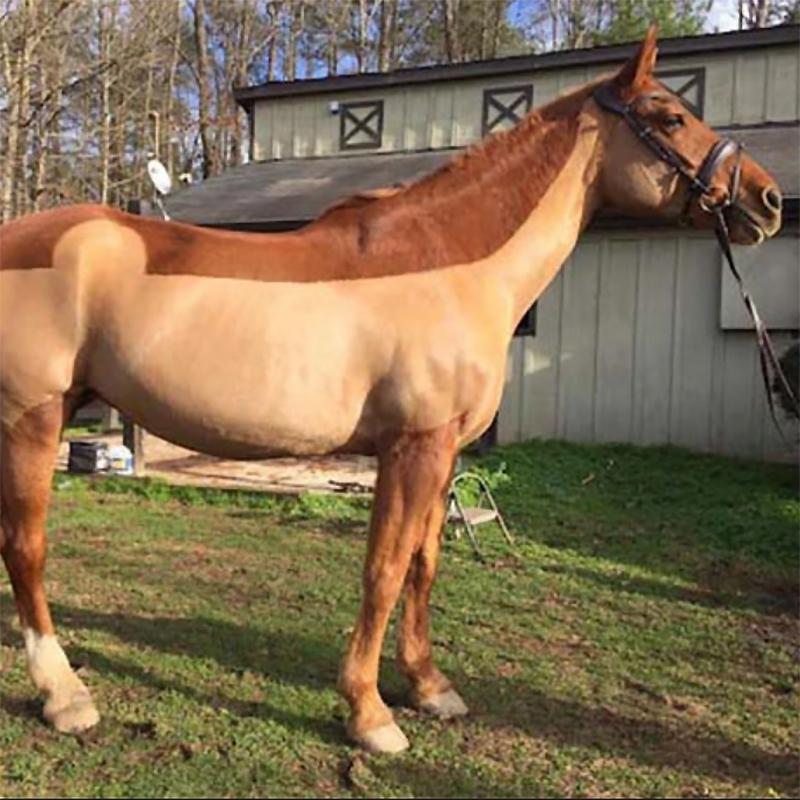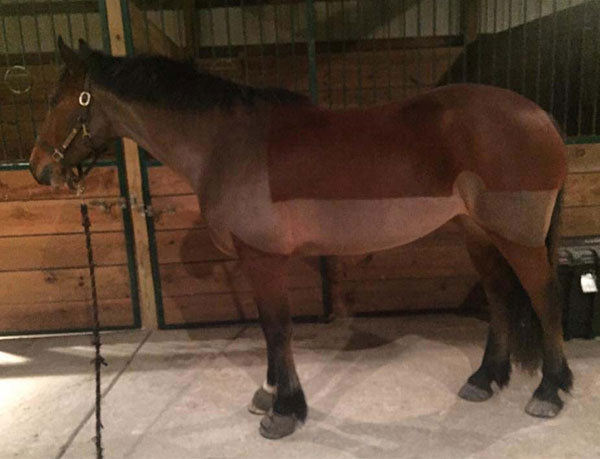

The Art of Bodyclipping
Article and Photos by Morgan Osbaldeston
Bodyclipping is when the body hair of a horse is shaved down using a set of professional grade animal clippers. The horse won’t be shaved down to the skin, but instead, a short length of hair will be kept. There are many clip patterns, from a “strip clip” which just takes a narrow strip of hair from under the horse’s jaw, down their neck, to their chest, to a “full clip” in which everything but a small triangle-shaped patch of hair will be left above the tail, the mane, forelock, and tail itself will be left.
There are a number of reasons why a horse may need to be clipped, and the reason may affect the type of clip the horse needs. However, some breeds and disciplines do not typically clip. Make sure to do your research to ensure the clip you choose is appropriate for your horse’s breed and discipline.
Competition
Many English sport horses will receive a full clip for showing. A full clip for the competition horse produces a shiny, well-kept appearance that is pleasing to the judge’s eye. It also means that if the horse sweats during the competition, it will be easier to tidy up between classes and easier in general to maintain and keep in top condition. When clipping for show, a full clip is usually the expectation as the patterns of other clips can cause optical illusions of imbalance and are considered more “casual” in appearance. Eventers and Foxhunters may choose a clip that leaves more protection for the horse’s skin.
Health
Some horses have conditions which affect their hair growth or sweat patterns. Conditions like Cushing’s disease often prevent a horse from shedding out its winter coat, whereas conditions like anhidrosis limit a horse’s ability to sweat. By clipping horses with conditions like these, their caregivers are better able to monitor their symptoms, body temperature, and comfort. Any style of clip that removes hair from the main surface area of the horse will do the job.
Time Management
In winter months, horses who are worked heavily or regularly, such as lesson horses or horses in training, will work up a sweat that leaves their heavy winter hair damp. It can be medically dangerous to leave a hot, wet horse standing in a cold stall, so some riders will have their horses clipped to cut down on the cooling and dry time after riding. Having the long, wooly hair removed also makes visual inspections of grooming and wellness faster and easier. The type of clip a horse gets in this scenario will depend on the horse’s workload, living situation, and human preference.
Fun!
Sometimes it is just fun to clip! Some riders will have small pieces of art clipped into their horse’s coat. These are commonly placed on the hip, shoulder, or more discreetly where the saddle will go so that it is not visible when the horse is tacked. Others will go all out with wild and creative designs across the body!
Examples
Full Clip
This clip removes all but a small triangle of hair above the tail (use the muscle lines to help draw this). Sometimes a saddle patch is left, the style of which is up to the owner.
 |
 |
 |
|
This Hunter show horse has a full |
This Arabian Hunter has a full clip with a “swoop” saddle patch. |
Finish the clip with a small triangle over the tail. |
Hunt Clip
This clip leaves the legs of the horse and traditionally, the head. Use the jowl line and shoulder muscle to determine your lines. Depending on preference, the leg line can follow the shoulder muscle or extend down the leg and a saddle patch may or may not be left. Sometimes, the whole head will be shaved. Sometimes the lower half of the head will be shaved - this line follows the cheek piece of the bridle. A small triangle of hair will be left above the tail.
 |
 |
| This Foxhunter has a Hunt clip with his full “fitted” saddle patch to help protect his back during the long rides, and extended leg lines to keep his elbows clear. |
This aged mare has a traditional Hunt clip with her head still “on”, leg lines that follow her muscles and a “swallowtail” saddle patch. |
 |
 |
| This Hunter show horse needed a clip for the off-season when he spends a lot of time turned out, but is still in training. |
This little guy was just too wooly! He got a hunt clip with a “full” saddle patch. |
Blanket Clip
This clip leaves a blanket shape over the back half of the horse, the legs, and can leave whole, half, or none of the head hair. The front of the “blanket” can have a square edge or a curved edge.
 |
 |
Trace Clip
This clip follows the traditional line of the “traces” of a harness. However, it is a popular clip for horses in light to moderate work. Legs stay “on,” but you can customize the traditional trace clip to be a low or high trace clip by adjusting the height of the trace line and choose a whole, half or no head.
 |
 |
| A traditional trace clip on a Ranch horse. |
A high trace clip with a half head on an Irish Sport Horse Eventer. |
Chase or Irish Clip
This clip starts near the stifle and rises in a diagonal line across the body to the poll. The head will usually be left on. This is best for horses in light work and seems most popular with Eventers.
 |
 |
Details and Designs
You can go big or small with “clip art” - something simple like a heart, or a full-body giraffe! Many owners will choose an image that coordinates with their horse’s name. Designs are usually placed on the near side hindquarters. Show horses might have one hidden under their saddle! Designs can be clipped in (hair shaved off) or clipped out (hair left on).

|
 |
 |
 |
 |
 |
 |
 |

|
 |
 |
 |
 |
Morgan Osbaldeston is a professional bodyclipper based out of Roswell, GA. She established her company CLIPclop in 2012 after years of clipping friends’ horses. She has three horses of her own, Preston, Timi and Wells. All clips in this article are her own creations. You can find CLIPclop on Facebook and Instagram.
Blog posts
-

-

April Fools' Day 2025 Test Run Giveaway!
Read nowEnter for your chance to win a one of three Breyer test run models!
-

A Special Edition of Your Favorite Pal!
Read nowWe're celebrating Pal O' Mine's 25th birthday in a very special way!


